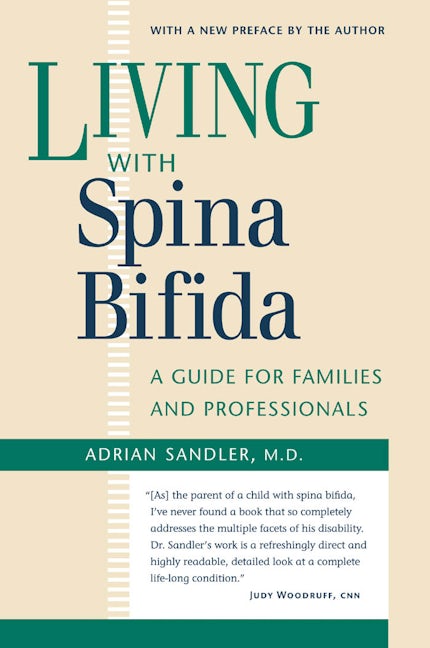Living with Spina Bifida
A Guide for Families and Professionals
By Adrian Sandler, M.D.

296 pp., 6.125 x 9.25, 93 illus., appends., bibl., index
-
Paperback ISBN: 978-0-8078-5547-8
Published: March 2004 -
E-book EPUB ISBN: 978-0-8078-6786-0
Published: March 2004 -
E-book PDF ISBN: 979-8-8908-7907-3
Published: March 2004
Buy this Book
Request exam/desk copyAuthor Q&A
Q: What is spina bifida?A: "Spina bifida" means a split or divided spine. It is a birth defect that occurs within the first month of pregnancy. The cause is not known with certainty, but it is likely that folic acid deficiency during the crucial early weeks of pregnancy sometimes contributes to the problem.The defect in the spine may occur anywhere along the spinal column. The spinal defect may be open or closed, but the term "spina bifida" is reserved for an open defect of the spine, in which the spinal cord does not form properly and is exposed.Most babies born with spina bifida also develop excess fluid in the ventricles (fluid spaces) in the brain. This problem is known as hydrocephalus and is typically treated in the newborn period with the placement of a shunt to drain the excess fluid.Q: How many babies are affected, and what is their prognosis?
A: About one in 1,000 children born in the United States have spina bifida. Medical advances and a more aggressive approach toward treatment over the past 15 years have improved the outlook. At least 85 to 90 percent of babies with spina bifida survive into adulthood. The critical issues then becomes how to improve function and enhance independence.Q: For whom did you write this book?
A: First and foremost, I am addressing the parents of children with spina bifida. The book contains most of the medical information that they will need to understand their child's condition and to participate actively in their child's health care. The book i s also written for pediatricians, family physicians, and other generalists who provide health care for children, adolescents, and adults with spina bifida. People in the allied health professions, including nurses, physical therapists, occupational therapists, and nutritionists, who provide therapeutic services to individuals with spina bifida will, I hope, benefit from reading a book such as this, as will teachers and school psychologists who will encounter students with spina bifida.Finally, the book is written for those with spina bifida. It has been increasingly evident from my own clinical work with children and adolescents with spina bifida that their own education about their condition is frequently overlooked. As they develop into adults, their independence and self-care depend on self-knowledge.Q: Don't family physicians already know what they should about spina bifida?
A: Not necessarily, because most general practitioners will have just a few affected individuals in their practices. Moreover, the management of spina bifida has undergone profound changes in the last twenty years, and many physicians may be unfamiliar with more recent management options.Q: Why do you suggest this book to educators?
A: As more and more children with spina bifida attend "regular" classes in school, the field of education (both "regular" and "special") must shoulder the responsibility of understanding and meeting the diverse needs of this population. Teachers and school psychologists, who must daily confront the educational and emotional impacts of spina bifida, will find much within my book that is especially relevant to their challenges.Q: What advice do you offer parents?
A: Form an effective partnership with the professionals treating your child. The key to maximizing your child's developmental outcomes and fulfilling her potential is to emphasize strengths and build on them. Think "abilities," not disabilities, and focus on the strengths rather than the deficits.
